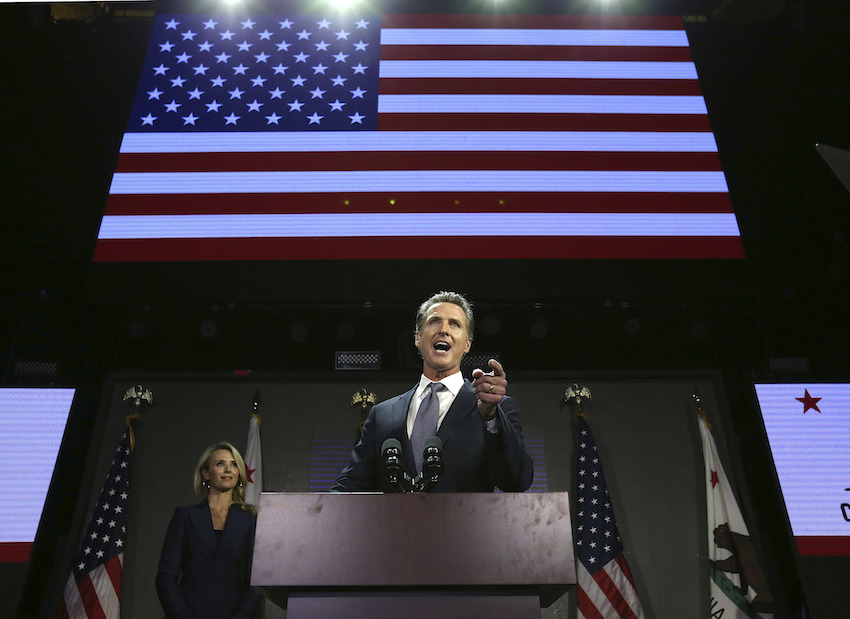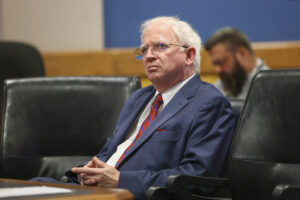The One and Only Way Democrats Can Retake the Country
California offers a testing ground to make broad changes using an approach the GOP has leveraged to the hilt in recent decades. California Gov.-elect Gavin Newsom addresses the crowd at a Nov. 6 election-night party as his wife, Jennifer Siebel Newsom, looks on. Newsom defeated Republican opponent John Cox to become his state's 40th governor, following outgoing Gov. Jerry Brown. (Rich Pedroncelli / AP)
California Gov.-elect Gavin Newsom addresses the crowd at a Nov. 6 election-night party as his wife, Jennifer Siebel Newsom, looks on. Newsom defeated Republican opponent John Cox to become his state's 40th governor, following outgoing Gov. Jerry Brown. (Rich Pedroncelli / AP)
With the media’s laser focus fixed on President Donald Trump, the election of Gavin Newsom as governor of California, plus the seating of an overwhelmingly Democratic state Legislature, slipped by without getting the attention it deserved.
Now these Democrats have the opportunity to show the nation what they can do. Can California, with so many rich and poor, including the largest percentage of homelessness in the U.S., ameliorate the income inequality that plagues the state and the rest of the nation?
It was encouraging that Newsom brought up such inequality at his televised election-night celebration, an occasion in which bringing up downbeat topics is usually considered to be in poor taste. “In many ways and in many places, we are simultaneously the richest and the poorest state,” he said in his victory speech. “The dream is far too distant for too many. We are a land of plenty, but we are far from perfect.”
A few days later, Gov.-elect Newsom met with reporters at St. Anthony’s Foundation, a social service agency assisting the poor in San Francisco, the city for which he served as mayor for two terms. There are, he said, “134,000 souls on the street in this state, 24 percent of the nation’s homeless. That is unacceptable and that’s our collective responsibility. It happened on our watch. That’s not a Democratic watch or a Republican watch. That’s our watch.”
St. Anthony’s is in downtown San Francisco, a setting that provides a prime example of what the former mayor-turned-governor is talking about. Despite Newsom’s good intentions and some efforts of the liberal city, a walk through downtown entails weaving through homeless people on streets that run by upscale high-rises where the tech, financial and legal elite work and live.
The situation is much the same in California’s largest city, Los Angeles. Encampments of homeless people have sprung up on the sidewalks and under the freeways next to high-rise office buildings and fashionable loft apartments downtown as well as in the growing and affluent high-tech area farther west toward the beach.
I’ve written about the development of this tragedy for years, explored the encampments and tried to figure out why, despite the efforts of well-meaning, smart people, the situation has gotten worse. A tangle of local government and relatively uninterested state government officials has certainly factored in, as has the very immensity of the problem. And with housing costs escalating, the outlook is grim as more people tumble from rental units into homelessness.
The Public Policy Institute of California, studying figures through 2016, said in a report titled “Poverty in California” that about 7.4 million of the most populous state’s 39.7 million residents can’t afford to pay for sufficient housing, food, medical care, transportation or other basic needs. A family of four would need an income of $31,000 a year to meet those needs.
Poverty is highest among children and Latinos. “Latinos remain disproportionately poor, making up 52.8 percent of poor Californians but [only] 39.2 percent of all Californians,” the report noted.
In another report, “Income Inequality and the Safety Net in California,” researchers at the Public Policy Institute said:
What may be most problematic is not the level or even the growth of inequality in itself—rather, it is the growth in inequality during a long period of rising economic productivity. Since 1997, the per capita gross domestic product (GDP) has increased by more than 30 percent in California. Over this same period, top incomes have grown at more than double the rate of low and middle incomes. This seems contrary to the idea that ‘a rising tide lifts all boats.’
Newsom takes over from Democratic Gov. Jerry Brown who, after two terms, is leaving the state with a surplus, the result of a tax structure that hits the high-income earners.
Brown did not take up the “Medicare for all” cause during his tenure; he also resisted calls for state-sponsored preschool education and two free years of community college, although he did sign legislation that provides for one free year. He also opposed raising tuition for California residents enrolled in the University of California and California State University systems.
Newsom has embraced all these ideas and then some, framing the initiatives in the context of income inequality. Free preschool education became a major theme of his campaign for governor. To ease housing costs, he has proposed the creation of a state bank to provide low-interest public financing to reach his goal of building 3.5 million new homes. His long-term aim is to make housing more affordable in a state in which it is becoming prohibitively expensive for much of the middle class in the coastal areas where the jobs are.
If Newsom and the Democratic Legislature achieve most of these goals, they would be returning to a tradition when social progress was a priority in many statehouses.
Those days seem distant in this era of ineffective or right-wing state legislatures. By neglecting state elections, national Democratic powers have been largely to blame for the Republican takeover of state governments around the country. This has resulted in anti-abortion, anti-labor and anti-voting rights laws in state capitals dominated by conservative Republicans.
All but forgotten is the fact that the beginnings of the New Deal came from a smart young New York team assembled by then-Gov. Franklin D. Roosevelt. The public universities and public-school systems built after the Great Depression and World War II came from the drawing boards of little-known state educators, architects, planners and scholars. They were gateways created to help the poor reach the middle class and beyond.
The temptation for politicians and the media will be to ignore poverty and focus on Trump, especially as evidence points to his use of the presidency for his own monetary gain.
This temptation will be great in Congress, given the Democrats’ strong majority in the House. And it will be great in the “blue state” of California, a center of resistance to Trump’s war on immigrants and the environment. Trump-bashing gets officeholders on cable news shows and racks up numbers on their social media accounts. Talking about early childhood education or about community colleges preparing people for a wired world, on the other hand, does not.
With the Trump fixation, Newsom’s campaign didn’t get the notice it deserved. As a result, Newsom was able to skate to victory without the close examination a candidate for governor needs.
Big tasks await Newsom and the rest of the Democrats, especially when it comes to protecting immigrants, Obamacare and environmental laws from the Trump administration. None is more important than income inequality, for it encompasses all of society’s ills. Without housing, transportation, clothing, nutritious food and a chance for a productive education, the lower classes are stuck.
Newsom’s postelection words on the gap separating the rich from working people and the poor after his election were encouraging—now the reality of governing is here. If Democrats, firmly in control of state government, can’t deal with the misery caused by income inequality in California, it can’t be done anywhere.
Your support matters…
Independent journalism is under threat and overshadowed by heavily funded mainstream media.
You can help level the playing field. Become a member.
Your tax-deductible contribution keeps us digging beneath the headlines to give you thought-provoking, investigative reporting and analysis that unearths what's really happening- without compromise.
Give today to support our courageous, independent journalists.






You need to be a supporter to comment.
There are currently no responses to this article.
Be the first to respond.